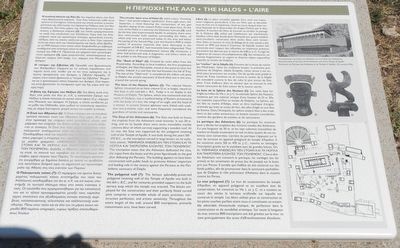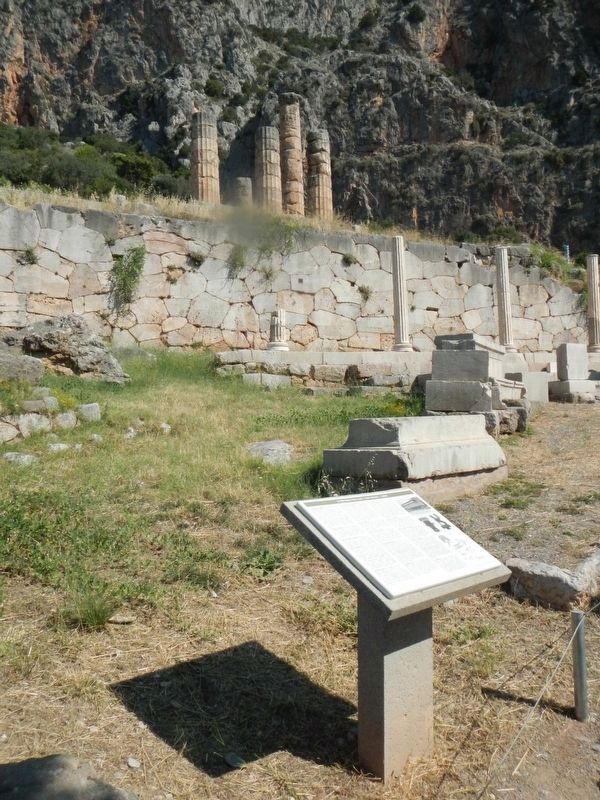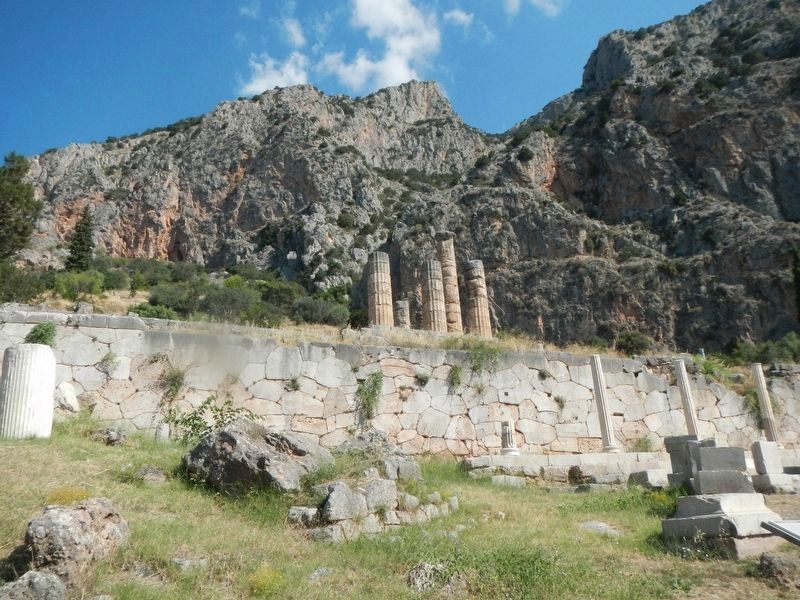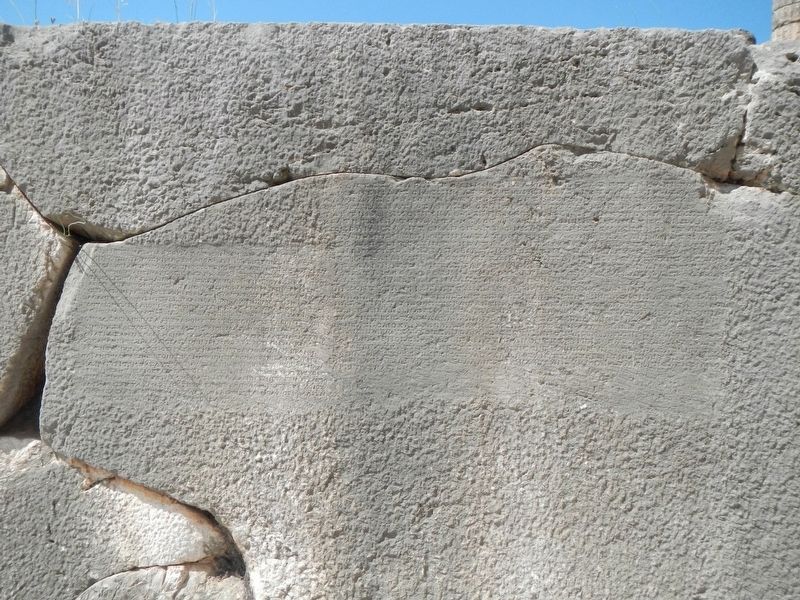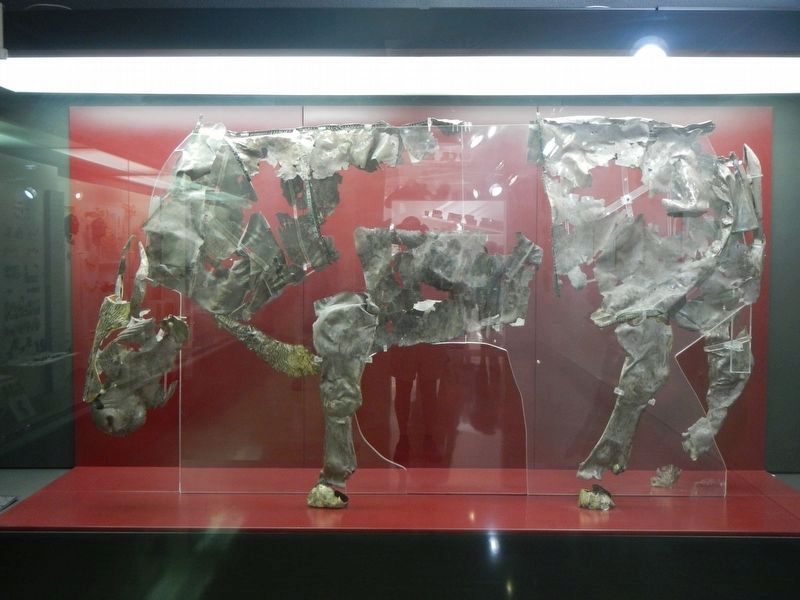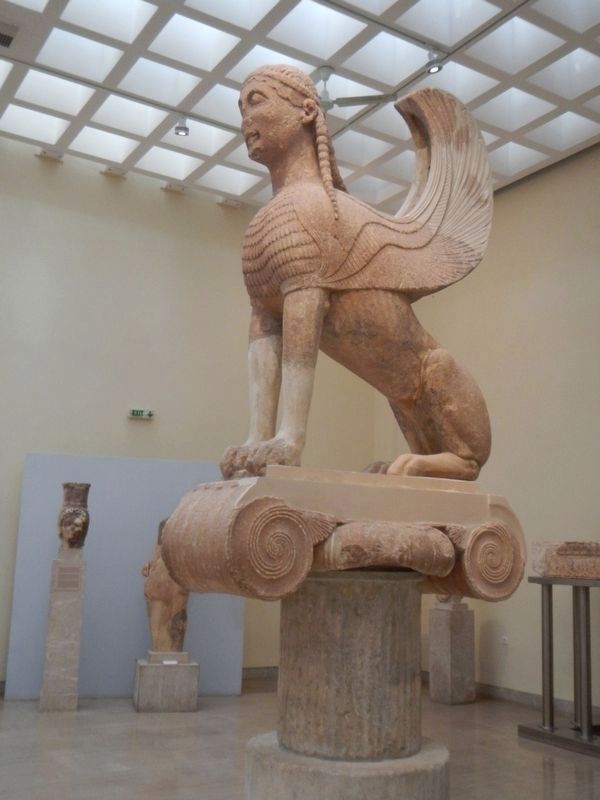Delfi in Phocis, Thessaly and Central Greece, Greece — Ελλάδα (Southeastern Europe, Balkan Peninsula)
The Halos
H ΠEPIOXH THΣ AΛΩ
— L'aire —
Inscription.
The texts on this marker are written in Greek (left), English (center) and French (right). Only the English text has been transcribed. To read the Greek and French texts, enlarge the marker image by clicking on it.
English:
The circular open area of Halos (1), which means "treshing floor". had a special religious significance. Every eight years, the Septerion, a ritual featuring the reenactment of the god Apollo's slaying of the serpent Pytho, took place here. At the rear of the Halos is a stairway, the Doloneia staircase (2), used by the boy who impersonated Apollo. It antiquity, there were four semi-circular built exedras surrounding the Halos, of which only to a preserved today. In this area and below the paving of the Sacred way, a pit was found in 1939 in which votives of precious materials that were destroyed in the earthquake of 548 B.C. had reverently been safeguarded. They included parts of chryselephantine statues (3), miniatures, a silver bull preserved only in fragments, and others which are on exhibit in the Museum of Delphi.
The "Rock of Sibyl" (4): Created by rocks fallen from the Phaedriadae. According to local tradition, the first prophetess of Delphi, the Sibyl Hierophile, stood at this point to utter her oracles. Indeed, it is said that she had foreseen the fall of Troy. The site of the "Sibyl rock" is considered the oldest cult place at Delphi; the ancient sanctuary of Earth (Ge) was in this area around the sacred spring.
The base of the Naxian Sphinx (5): The colossal Naxian Sphinx, mounted on an Ionic column 12 m. in height is on display in the Museum of Delphi. the Sphinx, which was connected with the myth of Oedipus, was a mythical being of Eastern provenance with the body of a lion, the wings of an eagle, and the head of a woman. In ancient Greece sphinxes were linked with tradition and primitive cults, and were frequently considered the guardian of tombs and sanctuaries.
The Stoa of the Athenians (6): The Stoa was built to house the trophies from the Athenian's naval victories. It was 30 m. long and on its façade there were seven monolithic marble columns (four of which survive) supporting a wooden roof. At its rear, the Stoa was supported by the polygonal retaining wall of the Temple of Apollo. It was build during the years 510-470 B.C., as the inscription carved in large letters on its stylobate attests: "AΘHNAIOI ANEΘΕΣAN TEN ΣTOAM KAI TA HOΠΛA KAI TAKPOTEPIA EΛONTEΣ TON ΠOΛEMION". This inscription notes that the Athenian dedicated the stoa, the ropes from the boats and the prow figureheads to the god after defeating the Persians. The building appears to have been constructed with public funds to promote Athens' important and leading role in the victory against the Persians at the Panhellenic sanctuary of Delphi.
The polygonal wall (7): The famous splendidly-preserved polygonal retaining wall of the Temple of Apollo was built in the 6th c. B.C., and for centuries provided support to the built terrace atop which the temple was erected. The blocks employed for the construction and their perfectly fitted curved joints comprise a remarkable whole of static precision, construction perfection, and artistic sensitivity. Throughout the entire length of the wall, around 800 inscriptions, primarily manumission acts, have been carved.
Erected by Greek Ministry of Culture and Sports.
Topics. This historical marker is listed in these topic lists: Anthropology & Archaeology • Man-Made Features.
Location. 38° 28.924′ N, 22° 30.093′ E. Marker is in Delfi, Thessaly and Central Greece, in Phocis. Marker can be reached from Ethniki Odos Livadias Amfissas (Route EO 48), on the left when traveling east. Touch for map. Marker is in this post office area: Delfi, Thessaly and Central Greece 330 54, Greece. Touch for directions.
Other nearby markers. At least 8 other markers are within walking distance of this marker. The Navel (within shouting distance of this marker); The Treasury of the Sikyonians and Siphnians
(within shouting distance of this marker); The Temple of Apollo (within shouting distance of this marker); The Altar of Chiots Area (within shouting distance of this marker); The Theater District (within shouting distance of this marker); Monuments of the Sacred Way (within shouting distance of this marker); The (Delphi) Theatre (about 90 meters away, measured in a direct line); The Roman Agora (about 90 meters away). Touch for a list and map of all markers in Delfi.
More about this marker. This marker is located in the Sanctuary of Apollo, below the Temple of Apollo.
Credits. This page was last revised on March 21, 2022. It was originally submitted on November 14, 2018, by Barry Swackhamer of Brentwood, California. This page has been viewed 339 times since then and 88 times this year. Photos: 1, 2, 3, 4, 5, 6. submitted on November 14, 2018, by Barry Swackhamer of Brentwood, California.
